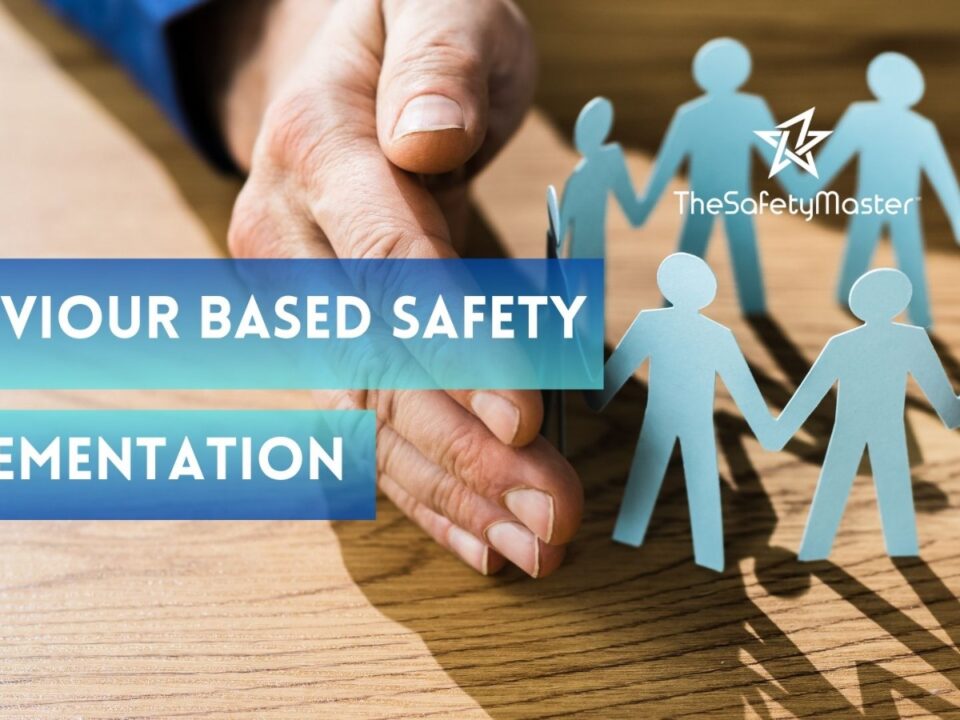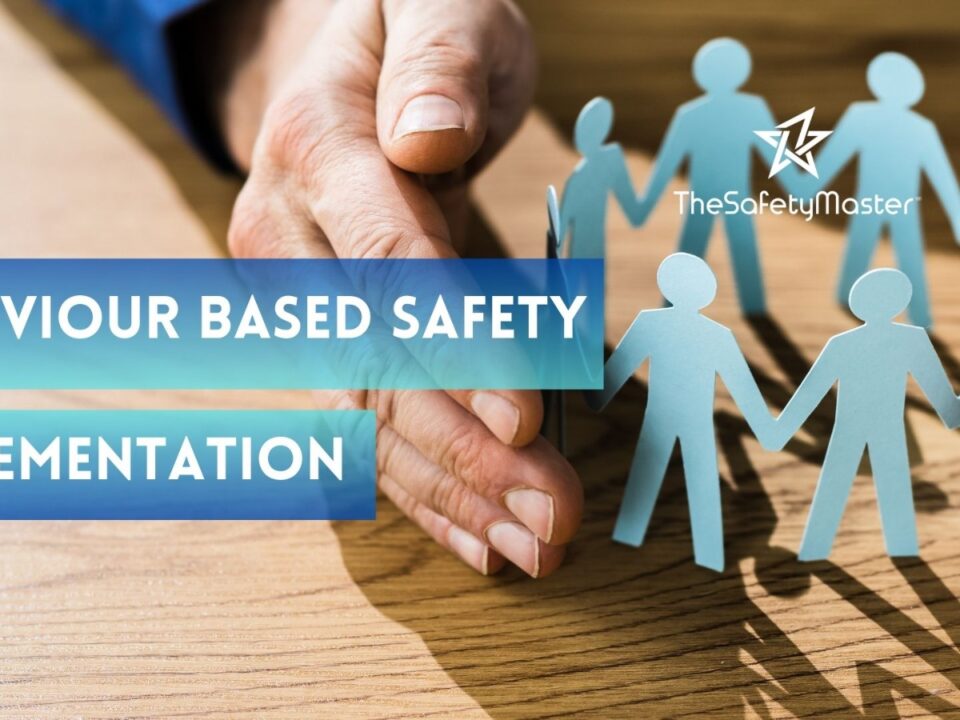Why Behaviour-Based Safety Implementation is a Game – Changer for Ensuring Employee Well-being and Productivity

How Do the Consultants Perform Fire Safety Audits in the Workplace?
May 20, 2025
Emergency Response Plan ERDMP
May 23, 2025In this article, we delve into a powerful concept that holds the potential to revolutionize workplace safety and productivity: Behaviour-Based Safety Implementation. With employee well-being and productivity taking centre stage in today’s fast-paced corporate landscape, it has become imperative for organizations to adopt proactive measures that go beyond traditional safety protocols. Discover how Behaviour-Based Safety Implementation aims to address the root causes of accidents and incidents by focusing on individual behaviours and choices. By doing so, this ground-breaking approach promises to create a culture of safety, boost employee well-being, and ultimately enhance productivity. Prepare to witness the transformative impact of Behaviour-Based Safety Implementation.
Introduction
Picture this: an organization with a highly motivated workforce, where employees feel safe, valued, and empowered to perform at their best. A workplace where accidents and injuries are minimized, productivity soars, and morale flourishes. Sounds like a dream scenario, doesn’t it? Well, that’s exactly what behaviour-based safety implementation can offer. In this article, we will delve into the fascinating realm of behaviour-based safety and explore how it can revolutionize employee well-being and productivity. We will uncover the underlying principles of this approach, dissect its impact on organizational culture, and reveal strategies for successful implementation. By the end of this journey, you’ll be armed with valuable insights that can transform your organization into a haven of safety and high-performance
Understanding Behaviour-Based Safety (BBS)
Understanding Behaviour-Based Safety (BBS): In the realm of workplace safety, Behaviour-Based Safety (BBS) stands as a transformative approach that delves into the intricacies of human behaviour to ensure a safer working environment. BBS recognizes that an individual’s actions and decisions play a fundamental role in their own well-being and that of their colleagues. By comprehending the intricate interplay between behaviour, environment, and consequences, BBS empowers organizations to proactively identify potential risks and develop effective intervention strategies.
At its core, BBS shifts the focus from mere compliance with safety regulations to fostering a culture of active engagement and ownership among employees. Rather than viewing accidents as unavoidable occurrences or blaming external factors, BBS recognizes that human behaviour is malleable and can be positively influenced through awareness, education, and supportive policies. This approach encourages workers to become active participants in creating a safe working environment by aligning their actions with best practices and continuously improving their behaviours.
By adopting Behaviour-Based Safety principles, organizations demonstrate a commitment towards prioritizing employee well-being while simultaneously enhancing productivity. By understanding the underlying causes of unsafe behaviours and taking proactive measures to address them, employers create an atmosphere of trust where employees feel valued for their input in shaping a safer workplace. Ultimately, this leads to increased job satisfaction, higher morale amongst workers, reduced absenteeism rates, improved teamwork dynamics, and overall enhanced organizational performance.
So let us delve deeper into the key principles behind Behaviour-Based Safety implementation – exploring how it analyses unsafe behaviours and hazards while promoting intervention strategies aimed at fostering a positive safety culture within organizations
The Importance of Ensuring Employee Well-being
The well-being of employees is the cornerstone upon which a thriving workplace ecosystem is built. It encompasses physical, mental, and emotional aspects that contribute to a harmonious and productive work environment. When organizations prioritize employee well-being, they recognize that their most valuable asset is not just their workforce but the individuals who comprise it, each with unique talents, aspirations, and potential. Ensuring employee well-being goes beyond mere compliance with safety regulations; it involves fostering a culture of care and support. Organizations that prioritize employee well-being understand that when employees feel valued and respected, they are more motivated to give their best efforts. This results in increased job satisfaction, higher levels of engagement, heightened creativity, and improved overall performance.
Furthermore, prioritizing employee well-being creates a positive ripple effect within the organization. When employees feel happy and fulfilled in their work environment, they are more likely to form strong relationships with colleagues and clients alike. This fosters collaboration and teamwork while enhancing customer satisfaction. Ultimately, by investing in employee well-being, organizations not only create an optimistic workplace but also pave the way for sustainable success in today’s competitive landscape.
Exploring the Impact of Behaviour-Based Safety on Productivity
Exploring the Impact of Behaviour-Based Safety on Productivity: Behavior-Based Safety (BBS) implementation has a profound impact on productivity within organizations. By focusing on employees’ actions and behaviours, this approach enables companies to identify potential hazards, reduce accidents, and enhance overall efficiency. When employees are actively engaged in safety practices, they become more attentive to their surroundings and adopt proactive measures to prevent incidents. This heightened awareness translates into increased productivity as workers can concentrate on their tasks without fear of harm or interruption.
Moreover, behaviour-based safety programs foster a positive work environment that encourages collaboration and open communication. When employees feel supported and valued in terms of their well-being, they tend to be more motivated and dedicated to their job responsibilities. This positive atmosphere cultivates teamwork and employee satisfaction, leading to higher levels of productivity. As individuals feel secure in reporting near-miss incidents or suggesting improvements, the organization benefits from a continuous feedback loop that drives innovation and efficiency.
In addition, behaviour-based safety implementation promotes a culture of accountability where employees take ownership for their actions. With regular observations and feedback from peers or supervisors, workers become more self-aware of their behaviours and strive for improvement. This conscious effort leads to a reduction in errors, increased attention to detail, and ultimately higher quality output. By aligning individual goals with organizational objectives through behaviour-based safety practices, businesses can optimize productivity while ensuring employee well-being remains at the forefront.
By comprehensively exploring the impact of behaviour-based safety on productivity, we witness how this proactive approach not only safeguards employees but also enhances workflow efficiency. Emphasizing safe behaviours creates an optimistic work environment where individuals are empowered to prioritize their own well-being while contributing towards the collective success of the organization
The Key Principles of Behaviour-Based Safety Implementation
The Key Principles of Behaviour-Based Safety Implementation: In order to establish a successful behaviour-based safety (BBS) program, several key principles must be followed diligently. First and foremost, it is essential to foster a proactive approach towards safety. This involves creating an environment where employees feel empowered to identify and report unsafe behaviours or hazards without fear of retribution. By encouraging open communication, organizations can ensure that potential risks are addressed promptly, leading to a safer workplace.
Secondly, BBS implementation requires comprehensive training programs that equip employees with the knowledge and skills necessary to practice safe behaviours. These programs should focus on raising awareness about potential hazards, providing practical guidance on risk mitigation techniques, and emphasizing the importance of personal responsibility in maintaining a safe working environment. By investing in continuous education and training, organizations demonstrate their commitment towards the well-being of their workforce.
Lastly, accountability plays a pivotal role in BBS implementation. It is crucial for organizations to establish clear expectations regarding safe behaviours and consistently reinforce them through positive reinforcement strategies. Recognizing and rewarding individuals who consistently prioritize safety not only boosts morale but also serves as an incentive for others to follow suit. By nurturing a culture of accountability within the workplace, organizations can create an atmosphere where safety becomes ingrained in every aspect of daily operations.
By adhering to these key principles, organizations can revolutionize their approach towards employee well-being and productivity through behaviour-based safety implementation. With proactive measures in place, adequate training programs offered, and accountability fostered at all levels of the organization, employees will feel confident in their ability to contribute positively while ensuring their own safety as well as that of their colleagues.
Identifying and Analysing Unsafe Behaviours and Hazards
In the realm of Behaviour-Based Safety (BBS) implementation, a pivotal step involves identifying and analysing unsafe behaviours and hazards that pose risks to employee well-being. By meticulously examining these elements, organizations can effectively develop targeted intervention strategies that promote a safer work environment. To identify unsafe behaviours, comprehensive observation programs are employed, allowing trained personnel to closely monitor employees in their workplace activities. This keen observation enables the detection of any potential deviations from established safety protocols or risky actions that may jeopardize employee safety. By pinpointing these unsafe behaviours, organizations gain valuable insights into the root causes of accidents and can initiate proactive measures to mitigate future risks.
Simultaneously, analysing hazards is essential in fortifying workplace safety. Hazards encompass potential sources of harm or danger such as faulty machinery, hazardous substances, or poorly maintained infrastructure. Conducting thorough hazard assessments allows organizations to identify potential vulnerabilities within their operations. Armed with this knowledge, they can promptly rectify such hazards by implementing engineering controls or establishing stringent safety procedures.
Through the diligent process of identifying and analysing both unsafe behaviours and hazards, organizations exhibit their unwavering commitment to prioritizing employee well-being. This proactive approach fosters a culture of trust where employees feel valued and protected within their work environment—a crucial factor in sustaining high productivity levels while ensuring occupational harmony.
Implementing Effective Intervention Strategies
Within the realm of behaviour-based safety implementation, effective intervention strategies play a pivotal role in promoting employee well-being and productivity. These strategies aim to intervene before accidents or incidents occur, addressing unsafe behaviours and hazardous conditions proactively. One key intervention strategy is providing comprehensive training programs that equip employees with the knowledge and skills necessary to identify risks and make safer choices. This includes educating them about potential hazards specific to their work environment and imparting techniques for mitigating those risks.
Moreover, implementing observation programs can be highly effective in identifying unsafe behaviours. Trained observers monitor employees’ actions and provide immediate feedback, reinforcing safe practices and offering corrective guidance when necessary. By encouraging a culture of supportive feedback, these interventions foster continuous improvement in safety performance.
An optimistic spin on these intervention strategies lies in their ability to empower employees by giving them the tools they need to ensure their own safety. By actively involving workers at all levels of the organization through training programs and observation initiatives, companies can cultivate a sense of ownership over safety processes. This not only enhances overall well-being but also promotes a positive work environment where everyone feels valued for their contribution to workplace safety.
Developing a Positive Safety Culture through Behaviour-Based Safety
Developing a Positive Safety Culture through Behaviour-Based Safety: Creating a positive safety culture is vital for the success of any organization’s behaviour-based safety program. It involves fostering an environment where safety becomes ingrained in every aspect of the workplace, from the top leadership down to frontline employees. Such a culture promotes open communication, trust, and accountability, making safety everyone’s responsibility.
One way to develop a positive safety culture is by encouraging active employee participation. By involving employees in identifying potential hazards and suggesting improvements, organizations empower them to take ownership over their own safety and that of their colleagues. This collaborative approach fosters a sense of unity and shared commitment towards maintaining a safe working environment.
Another key aspect is providing comprehensive training and education on behaviour-based safety practices. Employees need to understand not only what behaviours are expected but also why those behaviours are crucial for their well-being. By educating employees about the underlying principles behind behaviour-based safety, they gain a deeper understanding and are more likely to embrace these practices willingly.
In addition, recognition plays a significant role in cultivating a positive safety culture. Acknowledging and rewarding individuals or teams who consistently adhere to safe behaviours create positive reinforcement loops that motivate others to follow suit. Celebrating successes publicly fosters camaraderie and inspires others to strive for excellence in maintaining high safety standards.
By developing a positive safety culture through behaviour-based safety, organizations create an environment where employees feel valued, supported, and empowered—a place where they can thrive both personally and professionally while ensuring their well-being remains at the forefront.
Measuring and Evaluating the Success of Behaviour-Based Safety Programs
The measurement and evaluation of behaviour-based safety programs play a pivotal role in determining their effectiveness and ensuring continuous improvement. By utilizing robust assessment methods, organizations can track progress and identify areas for enhancement. One crucial aspect of measuring success lies in analysing the frequency and severity of incidents before and after implementing the program. This data allows for a clear comparison, providing insights into the program’s impact on reducing accidents and injuries. Furthermore, conducting regular employee surveys can capture valuable feedback on the perceived effectiveness of behaviour-based safety initiatives. These surveys enable organizations to gauge employee engagement, satisfaction, and awareness regarding safety practices. By actively involving employees in the evaluation process, organizations foster a sense of ownership and empowerment that contributes to sustaining a positive safety culture.
To complement quantitative data, qualitative assessments such as focus groups or individual interviews can delve deeper into employees’ experiences with behaviour-based safety programs. This qualitative approach uncovers valuable narratives, shedding light on any challenges or successes encountered during implementation. Such insights not only inform necessary modifications but also celebrate achievements, reinforcing enthusiasm among employees.
Measuring and evaluating the success of behaviour-based safety programs ensures that organizations remain proactive in addressing potential risks while fostering an environment that values employee well-being. By employing comprehensive assessment strategies encompassing both quantitative data analysis and qualitative feedback gathering techniques, businesses can refine their initiatives effectively. Ultimately, this commitment to continuous improvement enhances productivity while cultivating a workplace culture that prioritizes employee welfare—a true game-changer for modern organizations striving for excellence.
Overcoming Challenges in Behaviour-Based Safety Implementation
Overcoming Challenges in Behaviour-Based Safety Implementation: Navigating the turbulent waters of behaviour-based safety implementation can present its fair share of challenges. However, with determination and a strategic approach, these obstacles can be overcome, leading to lasting success. One common challenge is resistance to change. Employees may be hesitant to embrace new safety protocols, viewing them as an imposition on their established work routines. To tackle this, fostering open communication channels can help address concerns and provide reassurance that the implementation of behaviour-based safety is ultimately for their well-being.
Another hurdle lies in sustaining momentum and engagement throughout the implementation process. It is essential to create a supportive environment that encourages active participation from all levels of the organization. This includes providing ongoing training and refresher sessions to reinforce the importance of behaviour-based safety practices. By fostering a sense of ownership and collective responsibility for workplace safety, organizations can overcome this challenge and create a culture where everyone feels empowered to contribute.
Lastly, ensuring consistent compliance with behaviour-based safety practices can be challenging amidst varying work conditions or job demands. Regular monitoring and feedback mechanisms play a vital role in addressing this challenge. Utilizing technology solutions such as real-time data collection systems or mobile applications enables prompt identification of non-compliant behaviours and immediate intervention when necessary.
By acknowledging these challenges and proactively addressing them with thoughtful strategies, organizations can successfully implement behaviour-based safety programs that protect employees while boosting overall productivity – creating safer work environments where individuals thrive professionally while feeling valued and supported personally.
The Role of Leadership in Supporting Behaviour-Based Safety
The Role of Leadership in Supporting Behaviour-Based Safety Leadership plays a vital role in supporting the successful implementation of behaviour-based safety programs. A truly effective leader understands that safety is not just a box to check off, but rather an integral part of organizational culture. They set the tone by prioritizing safety and demonstrating their commitment through words and actions.
A forward-thinking leader fosters open communication channels where employees feel comfortable reporting unsafe behaviours or hazards without fear of reprisal. By actively listening and promptly addressing concerns, they create an environment that encourages transparency and trust. Such leaders understand that safety is a shared responsibility and actively involve employees in shaping safety protocols.
Furthermore, visionary leaders invest in comprehensive training programs to ensure that employees have the knowledge and skills to recognize potential risks and make informed decisions about their own safety. They provide ongoing support and resources, empowering individuals to take ownership of their actions and embrace safe behaviours both on and off the job.
In essence, strong leadership sets the foundation for a positive safety culture, where every individual feels valued, respected, and empowered to contribute towards a safer workplace. This not only enhances employee well-being but also drives productivity as workers are motivated to perform at their best knowing that their organization genuinely cares for their welfare.
By fostering effective leadership practices within organizations, behaviour-based safety becomes more than just another initiative – it transforms into an ingrained way of operating that propels both employee well-being and productivity to new heights.
Case Studies of Successful Behaviour-Based Safety Implementation
In the vast world of workplace safety, success stories often serve as beacons of hope and inspiration. Let us delve into a couple of remarkable case studies that demonstrate the transformative power of Behaviour-Based Safety (BBS) implementation in ensuring employee well-being and productivity. Our first case takes us to a bustling engineering firm where BBS became the cornerstone of their safety culture. By actively engaging employees in identifying unsafe behaviours and hazards, they fostered a sense of ownership and accountability. Regular safety observations were conducted, providing an opportunity to address concerns promptly. This led to a significant reduction in accidents and incidents, along with heightened employee morale. The positive ripple effect was palpable throughout the organization, creating an environment where everyone felt empowered to prioritize safety.
In another captivating example, a manufacturing company embraced BBS with unwavering commitment. Through comprehensive training programs, employees were educated on recognizing unsafe behaviours and encouraged to intervene constructively. A dedicated team was formed to analyse data from incident reports and identify trends that warranted immediate action. As a result, the company witnessed an impressive decline in accident rates alongside notable increases in productivity and overall job satisfaction among workers – demonstrating that investing in behaviour-based safety measures can yield substantial rewards for both employees and organizations.
The success stories shared here serve as testament to the transformative potential of Behaviour-Based Safety implementation when embraced wholeheartedly within an organization’s ethos. By fostering a strong safety culture that empowers employees at all levels to actively participate in identifying risks, intervening effectively, and continuously improving processes, companies unlock not only enhanced well-being but also increased productivity. These case studies illustrate that prioritizing safety is not just an obligation; it is an investment that pays dividends for all involved – creating workplaces where individuals thrive both professionally and personally
Conclusion
In conclusion, the implementation of behaviour-based safety is undoubtedly a game-changer for ensuring the well-being and productivity of employees. By focusing on identifying and analysing unsafe behaviours and hazards, implementing effective intervention strategies, and cultivating a positive safety culture, organizations can create an environment where employees feel empowered to prioritize their own safety. This not only leads to a significant reduction in accidents and injuries but also enhances overall productivity and employee engagement. As we move forward, let us embrace the transformative power of behaviour-based safety to create workplaces that prioritize both the physical and mental well-being of every individual involved, ensuring a brighter future for all.




